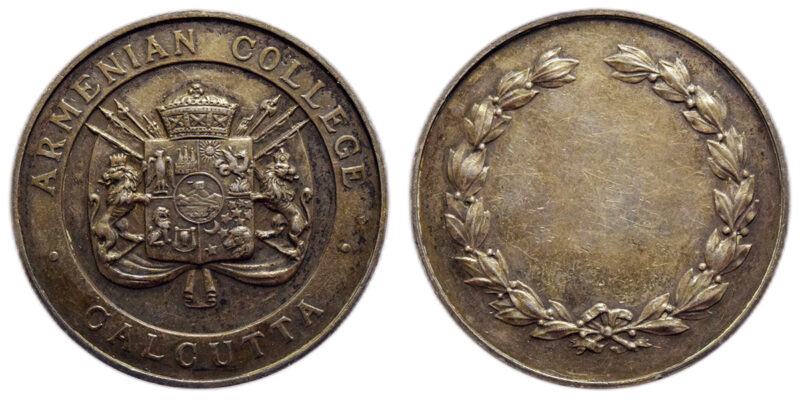The Armenian College in Calcutta, formally known as the Armenian College and Philanthropic Academy (ACPA), stands as a significant educational and cultural institution within the Armenian diaspora. Established in 1821 in the colonial heart of British India, the college was founded during a period when Armenians, long active in trade and commerce since the 16th century, sought to preserve their cultural identity while engaging with a rapidly changing socio-economic landscape. Its establishment reflects the community’s dual commitment to modern education and the preservation of Armenian heritage.

Reverse: Adorned with a laurel wreath framing a plain central field, typically left blank for inscriptions or dedications.
Specifications: Silver, 31.5mm, 13.47 g, 12h
Prior to its formal founding, Armenian educational activities in Calcutta began in 1798 with informal classes organized by the Armenian clergy at the Holy Church of Nazareth. These early initiatives were designed to ensure that the community’s youth were acquainted with Armenian language, religious traditions, and basic literacy. The transition from informal instruction to a structured institution was championed by influential New Julfa-born merchants, such as Astvatsatur Muradghanian and Mnatsakan Vardanian. Their vision materialized in the form of a dual curriculum that sought to provide a sound English education—integral for success in the colonial context—alongside the nurturing of Armenian language, history, and faith.
The success and growth of the college were closely linked to the support of Calcutta’s Armenian mercantile elite. Prominent community members contributed significantly to the college’s development, funding the construction of essential facilities and promoting a learning environment that blended modern educational practices with traditional Armenian cultural values. In 1884, the institution relocated to a campus on Mirza Ghalib Street. The new campus, characterized by an Indo-Saracenic architectural style, symbolized a harmonious blend of Armenian cultural identity with the prevailing British colonial aesthetic. This move not only underscored the institution’s evolving role in the community but also its adaptation to the broader cultural and political environment of Calcutta.
The college’s curriculum and institutional policies evolved over the decades. In the early 20th century, there was a marked shift towards inclusivity and gender integration. Initially an all-boys institution, the Armenian College eventually integrated girls’ education, culminating in the merger with the Davidian Girls’ School in 1953. This development paralleled broader social changes within both the Armenian diaspora and the host society, as educational institutions began to embrace coeducation and expand their curricular offerings to include vocational training and other disciplines vital for the empowerment of women.
Cultural preservation has remained a core objective of the Armenian College throughout its history. The establishment of the Araratian Library in 1828, which once housed over 1,000 manuscripts including rare theological works and merchant records, is testament to the college’s commitment to safeguarding Armenian intellectual and cultural heritage. Alongside traditional academic pursuits, the college also supported various publishing initiatives and cultural activities that fostered cross-cultural dialogue between the Armenian community and the broader Indian society.
In contemporary times, the Armenian College continues to play a pivotal role in the preservation and transmission of Armenian culture while adapting to the demands of modern education. Under the stewardship of the Armenian Apostolic Church, the college now serves a diverse student body that includes individuals from Armenia, Iran, Iraq, and Russia. The curriculum today integrates Indian state syllabi with comprehensive Armenian studies, ensuring that graduates are well-equipped to navigate both diasporic identity and global citizenship. Moreover, strategic partnerships with institutions such as Yerevan State University have modernized facilities and expanded scholarship opportunities, thereby ensuring the college’s continued relevance despite the dwindling size of the local Armenian community.
